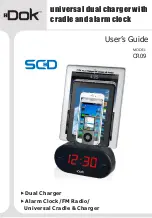
Hysteresis
To compensate for fluctuation of the measured data, which may
cause the weather alarm to sound constantly if the measured reading
is close to user set level, a hysteresis function has been implemented
for each weather alarm. For example, if the high temperature alarm is
set to +77°F and the current value moves to +78°F, the alarm will be
activated (if it has been enabled). Now when the temperature drops to
+76°F or below and thereafter again increases to 77°F, the
data will be blinking, but no alarm will be activated. It has to drop to
below +75.2°F (with a pre-set hysteresis of 1.8°F) so that the alarm
can be produced again. Hysteresis values for the various weather
data types are given in the following table:
Weather data
Hysteresis
Temperature 1.8°F
Humidity 3%
RH
Air pressure
0.0295 inHg
Rainfall 24h
0.1968 inch
Rainfall 1h
0.01968 inch
Wind
3.1 mph
16.
Auto memory for stored values
The base station has a memory back up system, which is used to
memorize user-defined settings for when the batteries are changed or
if a power failure occurs. User defined units are automatically updated
each time these are changed. The base station will memorize the
following user defined units:
•
Time
zone
•
12/24h time display mode
•
Unit settings (temperature, pressure, rainfall, wind)
•
Air pressure offset for calculation of relative air pressure
•
Weather picture threshold
•
Storm warning threshold
•
LCD
contrast
•
Alarm
time
•
Weather Alarm thresholds
•
State of alarms (enabled/disabled)
•
Rainfall total value and reset time/date
17. Accessories:
adding
cable
extensions
For your convenience, additional telephone cables to increase the
connection distance between each of the units may be purchased
from any reputable hardware store. Simply add these to the current
cables to extend your cable connection distance.
When securing the cables during mounting, ensure that base station
can receive the weather data since increasing the cables lengths may
also increase levels of interference and result with reception difficul-
ties. Interference levels will greatly depend on the surrounding area
for example setting up on or near metal piping may considerably
reduce reception.
For best results, do not to add more than 32ft of extension cable from
item to item onto the existing cable lengths as this may reduce recep-
tion levels. Again, reception and interference levels will greatly de-
pend on the surrounding environment at your point of mounting.
Note:
It is important to keep all the connected extension heads away from
rain, moisture and other extreme weather conditions as exposure can
cause short circuits and damage to this item.
Telephone Extension Cables
















































